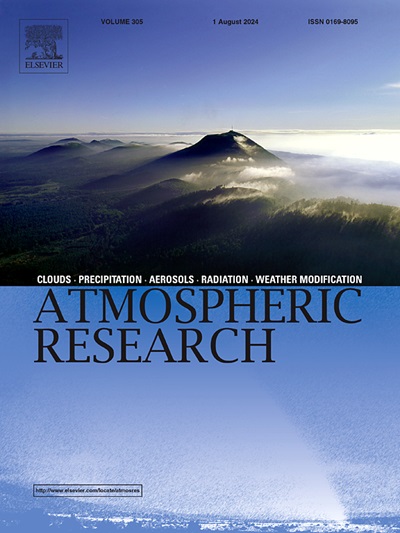南极洲东部德龙宁毛德地极端降水事件--利用极地 WRF 模式进行的大气河流事件案例研究
IF 4.5
2区 地球科学
Q1 METEOROLOGY & ATMOSPHERIC SCIENCES
引用次数: 0
摘要
极端降水事件(EPEs)对南极洲至关重要,会影响南极冰盖的表面质量平衡和稳定性。全面的案例研究对于更好地了解这些事件及其背后的驱动过程至关重要。在此,我们研究了 2015 年 11 月 8 日和 9 日在南极洲东部德龙宁毛德地(DML)发生的极端降雪事件。这次降雪事件在不到两天的时间里造成了约 22% 的年积雪量,降水分布的空间变异性很大。我们采用了专为极地地区优化的高分辨率大气模型(极地 WRF)和ERA5 再分析数据,对该事件进行了详细分析。我们的研究结果突显了创纪录强度的阻挡高压脊的重要性,它有效地阻挡了强热带外气旋并使其转向 DML,最终导致了这次强降雪事件。气旋的突然加深是由高层大气中的 "喷流条纹 "引发的,它将该系统引向东南方的南极海岸。值得注意的是,我们在 2015 年 11 月 7 日观测到了异常高的极地水汽输送,其形式为一条强大的大气河流。这条大气河发源于南大西洋,从南纬 30 度-40 度纬度带向极地移动。模式输出的垂直剖面图显示,大部分降水都集中在大气河流路径沿线地形陡峭的地区。大气河流与陡峭地形之间的相互作用导致海洋性空气抬升,造成大雪。这项研究突出表明,极端的上下大气条件在推动水汽向 DML 沿海地区强烈输送方面具有重要意义。大气河流与陡峭地形之间的相互作用导致了大量降雪,突出表明了在理解南极洲极端气候事件时考虑地形影响的重要性。本文章由计算机程序翻译,如有差异,请以英文原文为准。
An extreme precipitation event over Dronning Maud Land, East Antarctica - A case study of an atmospheric river event using the Polar WRF Model
Extreme precipitation events (EPEs) are crucial in Antarctica, impacting the Antarctic ice sheet's surface mass balance and stability. Comprehensive case studies are essential for better understanding these events and the underlying processes driving them. Here, we investigate an extreme snowfall event in Dronning Maud Land (DML), East Antarctica on November 8 and 9, 2015. This event contributed approximately 22 % of the annual accumulation in less than two days and exhibited high spatial variability in precipitation distribution. We employed a high-resolution atmospheric model specifically optimized for the polar regions (Polar WRF) and ERA5 reanalysis data to analyze the event in detail. Our findings highlight the importance of a blocking high-pressure ridge of record strength that effectively blocked and diverted a strong extratropical cyclone into DML, ultimately leading to the heavy snowfall event. The sudden deepening of the cyclone was initiated by a ‘jet streak’ in the upper atmosphere that steered the system southeastwards towards the Antarctic coast. Notably, we observed an anomalously high poleward moisture transport in the form of a strong atmospheric river on November 7, 2015. This atmospheric river originated in the South Atlantic Ocean and tracked poleward from the 30°S-40°S latitude band. Vertical cross-sections of the model outputs indicate that most of the precipitation was concentrated in regions with steep orography along the path of the atmospheric river. This interaction between the atmospheric river and the steep terrain led to the uplift of maritime air, resulting in heavy snowfall. This study highlights the significance of extreme upper and lower atmospheric conditions in driving intense moisture transport towards coastal DML. The interaction between the atmospheric river and the steep orography contributed to heavy snowfall, underscoring the importance of considering orographic influences in understanding EPEs in Antarctica.
求助全文
通过发布文献求助,成功后即可免费获取论文全文。
去求助
来源期刊

Atmospheric Research
地学-气象与大气科学
CiteScore
9.40
自引率
10.90%
发文量
460
审稿时长
47 days
期刊介绍:
The journal publishes scientific papers (research papers, review articles, letters and notes) dealing with the part of the atmosphere where meteorological events occur. Attention is given to all processes extending from the earth surface to the tropopause, but special emphasis continues to be devoted to the physics of clouds, mesoscale meteorology and air pollution, i.e. atmospheric aerosols; microphysical processes; cloud dynamics and thermodynamics; numerical simulation, climatology, climate change and weather modification.
 求助内容:
求助内容: 应助结果提醒方式:
应助结果提醒方式:


